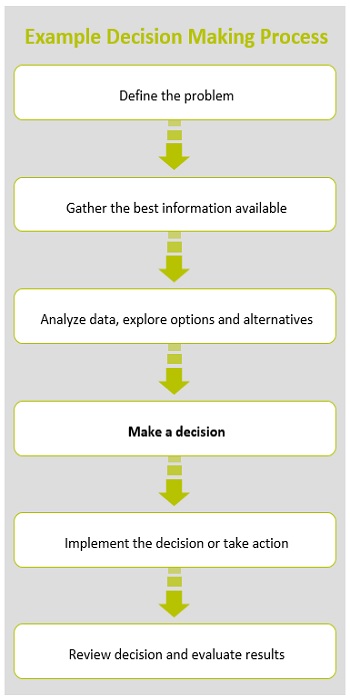
No matter who you are or what you do, you will constantly be making decisions. What to eat, what to wear, who to see or where to go. Some of us find it easy to quickly look at our options, make a decision and just go for it. But others will find making decisions difficult and can sometimes be paralyzed by the different options available. So how can we make those key decisions at home and work easier?
It’s important to remove internal conflict and check we know what our values are. A decision is simply a conclusion or resolution reached after consideration. In psychology, decision-making is regarded as the cognitive process resulting in the selection of a belief or a course of action among several possible alternatives. The final choice may or may not prompt any action and can either be a rational or irrational decision based on our assumptions, preferences, beliefs and values.
“It is not the strongest of the species that survives, nor the most intelligent; it is the one most adaptable to change.”
Quote: Charles Darwin
But it’s our values that act as the essential rules on which we build the guiding principles of our life. They are at the core of our belief system and as such, they will underpin every decision we make. If our actions are not in harmony with our own personal values, it can create internal conflicts that are difficult to resolve. For this reason, once we know what our values are, it’s easier for us to make positive life choices when making decisions.
It can help if we understand the different steps within the decision-making process. Senior leaders are being asked to make decisions that impact not only their organization, but also their customers and employees.
One question to ask yourself is – “What will the short, medium or long term consequences be?”
Processing our decisions can help us clearly see the options available and understand the positive or negative impact our decision could have. This can really help if we ever need to explain our actions, justify our decision or resolve any internal conflict we may have.

Step one – Define the problem. It’s important to understand the objective, rules and restrictions, then set out the timeline.
Step two – Gather the best information available. Try to establish the facts, then going back to the initial step to ensure you have all the necessary data and it comes from a variety of different sources.
Step three – Analyze the data, then explore the options and alternatives. As the first idea is seldom the right one, it’s better to be methodical so you don’t rule out too quickly something that seems too daring or that initially didn’t strike you as worth exploring. It’s also worthwhile to avoid the pitfall of going backwards and forwards over an idea or getting stuck in a rut. If you do get stuck, break the problem down into bite-size pieces or ask for help so you have different views of the same situation.
At the analysis stage, it is of course important to weigh up the pros and cons of each option, i.e. assess the impact of each potential solution, both for other people and yourself to see if it aligned with your values. Listening to your feelings is important because being governed by reason alone isn’t enough. You need to assess the potential difficulty of implementing each solution and put in place a backup plan in case things don’t go as expected.
Step four – Make a decision. Making a choice invariably means giving up something else, so don’t always worry about making the perfect decision. Some people may prefer not to make a decision and simply let the situation time out or reach a natural conclusion. However, not making decisions, was itself a decision.
Step five – Implement the decision. You will normally focus more on some aspects over others, so it’s important before you implement the solution to think about how you will explain it to others or defend it in the event of objections or resistance.
Step six – Review the decision and evaluate the results. At the end of the day, you know you’ve made the right decision when you feel in harmony with the situation. The right decision can then open up different possibilities, so be ready to get on board and face any difficulties that arise. But also be ready to adjust or adapt if needed and if you do ever make the wrong choice, don’t see it as a failure but as a lesson to be learned.
It will normally help if you are in a positive frame of mind before making a key decision. For example, if we look at a problem as an opportunity to grow smarter and wiser, we are less likely to think of it as a threat to how we like to do things.
Changing the way we approach things and thinking outside the box can be exciting and inspiring. But will only help if we are truly open to the many opportunities life presents us with each day.
If you would like to help your clients resolve any internal conflicts they may have when making key decisions or review their personal and professional values, check out our ebook in the online shop:
Coaching Personal and Professional Values – Help your clients identify their key values and agree clear goals with this complete toolkit for coaching both personal and professional values. It also includes a simple step by step guide to use in your coaching sessions.
We have published a full range of resources specifically aimed at supporting you as a professional coach, so please check our on-line shop and look at the full range of games, ebooks and kits. Or read some of the other blog posts written by our team of international coaches.
Please note – Our materials can only be copied and distributed, if you include a reference and link to the original source: (cc) MyCoachingToolkit.com – 2023